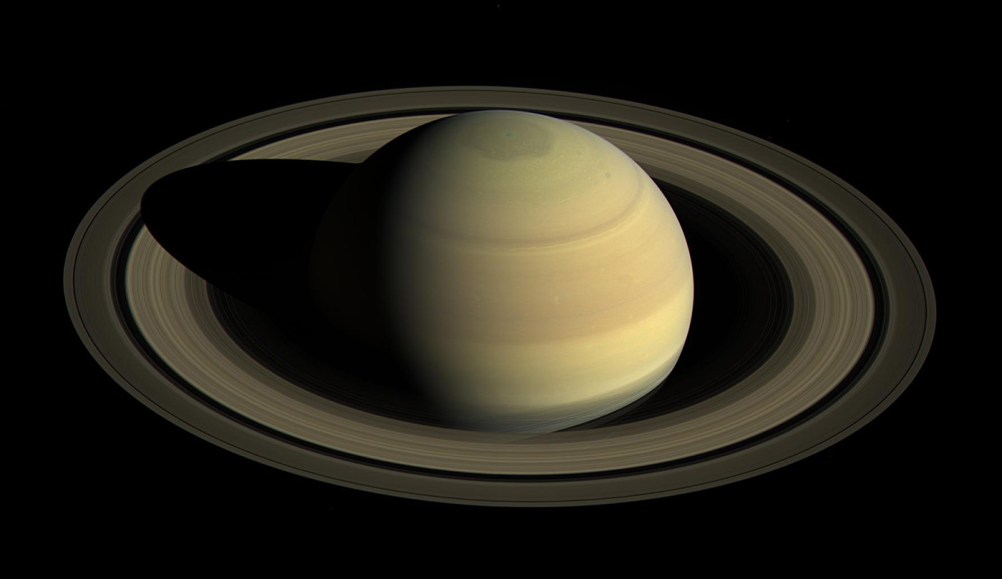A missing moon could have given Saturn its rings — and tilt
The idea could explain some things about the planet once thought to be unrelated

The origins of Saturn’s iconic rings are a mystery. So is the planet’s tilted orbit. A single missing moon could explain both.
Space Science Institute, JPL-Caltech/NASA
Share this:
- Share via email (Opens in new window) Email
- Click to share on Facebook (Opens in new window) Facebook
- Click to share on X (Opens in new window) X
- Click to share on Pinterest (Opens in new window) Pinterest
- Click to share on Reddit (Opens in new window) Reddit
- Share to Google Classroom (Opens in new window) Google Classroom
- Click to print (Opens in new window) Print
A single, doomed moon could clear up a couple of mysteries about Saturn.
The suspected missing moon is named Chrysalis. If it existed, it could have helped tilt Saturn over. That, in turn, could have thrown the moon’s orbit into chaos. This might have led to the moon getting shredded by Saturn’s gravity. And such lunar debris could have formed the iconic rings that encircle Saturn today.
Jack Wisdom and his colleagues suggest this idea in the Sept. 15 Science. Wisdom is a planetary scientist at the Massachusetts Institute of Technology in Cambridge.
“We like [the idea] because it’s a scenario that explains two or three different things that were previously not thought to be related,” Wisdom says. “The rings are related to the tilt. Who would ever have guessed that?”
@sciencenewsofficial How did Saturn get its rings and its tilt? A single missing moon could solve both mysteries. #Saturn #Titan #moon #science #space #learnitontiktok
♬ original sound – sciencenewsofficial
Two mysteries, one explanation
The age of Saturn’s rings is a longstanding mystery. The rings appear surprisingly young — a mere 150 million years old or so. Saturn itself is more than 4 billion years old. So if the dinosaurs had telescopes, they might have seen a ringless Saturn.
Another mysterious feature of the gas giant is its nearly 27-degree tilt relative to its orbit around the sun. That tilt is too large to have formed when Saturn did. It’s also too big to be from collisions knocking the planet over.
Planetary scientists have long suspected Saturn’s tilt is related to Neptune. The reason: a coincidence in the timing in how the two planets move. Saturn’s axis of rotation wobbles like a spinning top. Neptune’s entire orbit around the sun wobbles like a struggling hula hoop. The rhythm of those two wobbles is almost the same. This phenomenon is known as resonance.
Scientists thought that gravity from Saturn’s moons — especially its largest, Titan — helped the planetary wobbles match up. But some features of Saturn’s interior were not known well enough to prove that the timing of the two was linked.
Wisdom was part of a team that reviewed precise data on Saturn’s gravity. Those data had been supplied by NASA’s Cassini spacecraft. This space probe plunged into Saturn in 2017 after having orbited the gas giant for 13 years. Those gravity data revealed details of the planet’s internal structure.
Specifically, Wisdom’s team found Saturn’s “moment of inertia.” That value relates to how much force would be needed to tip the planet over. The moment of inertia was close to, but not exactly, what it would be if Saturn’s spin were in perfect resonance with Neptune’s orbit. That suggests something else must have helped Neptune nudge Saturn over.
Explains Wisdom, “That’s where this [moon] Chrysalis came in.”
The team realized that another smallish moon would have helped Titan bring Saturn and Neptune into resonance by adding its own gravitational tugs. Titan drifted away from Saturn until its orbit synced up with that of Chrysalis. The extra gravitational kicks from the larger moon (Titan) would have sent the smaller moon (Chrysalis) on a chaotic dance. Eventually, Chrysalis would have swooped so close to Saturn that it grazed the giant planet’s cloud tops. At this point, Saturn would have ripped the moon apart. Over time, the moon’s pieces slowly ground into bits, making up the planet’s rings.
How a missing satellite might form Saturn’s tilt and its rings
When Saturn formed, its spin axis was probably nearly straight up and down — like a top that has just been spun (1). But Titan, Saturn’s moon, gradually moved away from the planet. As a result, interactions between Titan, another moon called Chrysalis and the planet Neptune could have helped tilt Saturn. In fact, they could have tipped the planet over by 36 degrees (2). Chaos would ensue, leading to the destruction of Chrysalis. The shredded moon would form Saturn’s rings. Losing that moon also let Saturn’s tilt angle relax a bit to its present-day tilt, which is about 27 degrees (3).
A doomed moon
Plausible, but not probable
Computer models show that the scenario works. But it doesn’t work all the time.
Only 17 out of 390 simulated scenarios ended with Chrysalis breaking apart to create the rings. But this scenario being unlikely doesn’t mean it’s wrong. Massive, dramatic rings like Saturn’s are rare, too.
The name Chrysalis came from the moon’s hypothesized spectacular ending. “A chrysalis is a cocoon of a butterfly,” Wisdom says. “The satellite Chrysalis was dormant for 4.5 billion years, presumably. Then suddenly the rings of Saturn emerged from it.”
The story hangs together, says Larry Esposito. This planetary scientist at the University of Colorado Boulder was not involved in the new work. But he’s not entirely convinced by the Chrysalis idea.
“I think it’s all plausible. But maybe not so likely,” he says. “If Sherlock Holmes is solving a case, even the improbable explanation may be the right one. But I don’t think we’re there yet.”






